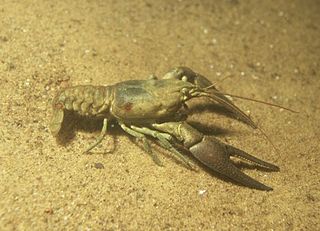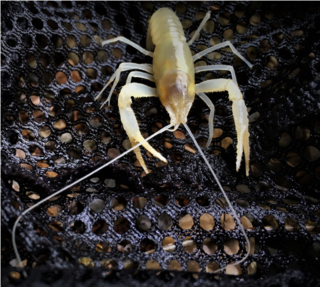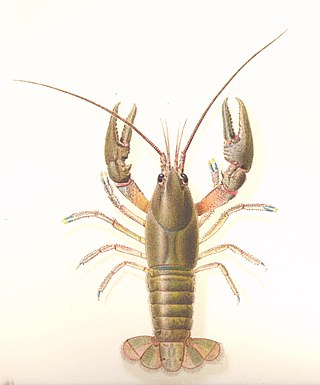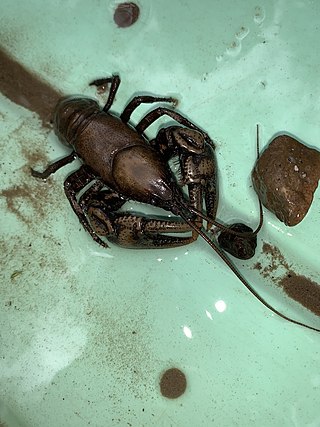
Cambarus is a large and diverse genus of crayfish from the United States and Canada. The adults range in size from about 5 cm (2.0 in) up to approximately 15 cm (5.9 in).

Cambarus aculabrum is a rare species of cave-dwelling crayfish known by the common name Benton county cave crayfish. It is native to Arkansas in the United States, where it is known from only four locations. It is a federally listed endangered species of the United States.
Cambarus bouchardi, the Big South Fork crayfish, is a species of crayfish in the family Cambaridae. It is found in North America.
Cambarus coosawattae, the Coosawattae crayfish, is a species of crayfish in the family Cambaridae. It is endemic to Georgia. The common name refers to the Coosawattee River, with the original specimens being collected in the Cartecay River which combines with another river to form the Coosawattee.
Cambarus cymatilis, the Conasauga blue burrower is a species of burrowing crayfish in the family Cambaridae. It is native to Tennessee and Georgia in the United States. The common name refers to the Conasauga River.
Cambarus elkensis, the Elk River crayfish, is a species of crayfish in the family Cambaridae. It is endemic to West Virginia in the United States.

Cambarus fasciatus, the Etowah crayfish, is a species of crayfish in the family Cambaridae. This species is endemic to Georgia, where it is state listed as S2.
Cambarus harti, the Piedmont blue burrower, is a species of burrowing crayfish in the family Cambaridae. It is endemic to Georgia in the United States. The common name refers to the Piedmont plateau region.
Cambarus obeyensis, the Obey crayfish, is a species of crayfish in the family Cambaridae. It is found in North America.

Cambarus scotti, the Chattooga River crayfish, is a species of crayfish in the family Cambaridae. It is endemic to Alabama and Georgia. The common name refers to the Chattooga River. The original specimens were collected from Clarks Creek in Chattooga County.
Cambarus speciosus, the beautiful crayfish, is a species of crayfish in the family Cambaridae. It is endemic to Georgia.
Cambarus subterraneus, the Delaware County cave crayfish, is a species of crayfish in the family Cambaridae. It has been found only in three caves in Delaware County, Oklahoma.
Cambarus tartarus, the Oklahoma cave crayfish, is a species of crayfish in the family Cambaridae. It is endemic to two caves in Delaware County, Oklahoma in the United States.
Cambarus williami, the Brawleys Fork crayfish, is a species of crayfish in the family Cambaridae. It is endemic to Tennessee.

Cambarus zophonastes, also known as the Hell Creek Cave crayfish, is named for its original location of discovery, Hell Creek Cave. It is also found in other similar habitats in Stone County and Marion County, Arkansas. These habitats include springs and caves such as Nesbitt Spring Cave in Stone County. C. zophanastes is critically endangered according to the IUCN. C. zophanastes is also protected by the ESA as an endangered species. Currently conservation efforts focus on monitoring populations, reducing disturbances, and monitoring water quality. More research has to be conducted to better understand and conserve the species.

Faxonius shoupi, the Nashville crayfish, is a freshwater crustacean native to the Mill Creek Basin in Nashville, Tennessee. Prior to August 2017, the species was called Orconectes shoupi. Faxonius shoupi is protected under the Endangered Species Act (ESA) as an endangered species. However, the crayfish has recently been put up for delisting by the United States Fish and Wildlife Service.

The Big Sandy crayfish, Cambarus callainus, are freshwater crustaceans of the family Cambaridae. They are found in the streams and rivers of Appalachia in Virginia, West Virginia, and Kentucky, in what is known as the Big Sandy watershed. Populations are often mistaken with Cambarus veteranus, but morphological and genetic data suggest that these are separate taxa; however, both are protected under the Endangered Species Act. There is very little information available on the Big Sandy crayfish because it is a relatively new species.

Cambarus robustus, known generally as the robust crayfish or Big Water crayfish, is a species of crayfish in the family Cambaridae. It is found in North America.

Cambarus carinirostris, the rock crayfish, is a species of crayfish in the family Cambaridae. It is found in the mid-Atlantic region of the United States.

Cambarus acuminatus, the acuminate crayfish, is a species of crayfish in the family Cambaridae. It is found in eastern North America.










